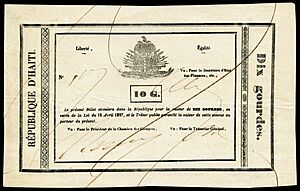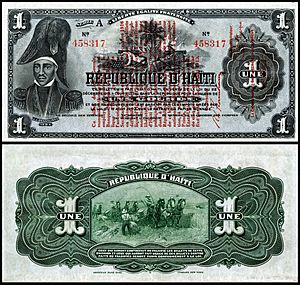Haitian gourde facts for kids
Quick facts for kids Haitian gourde |
|
|---|---|
| ISO 4217 Code | HTG |
| User(s) | |
| Inflation | 22.8% |
| Source | The Global Economy, 2020 |
| Superunit | |
| 5 | Dollar ($) |
| Subunit | |
| 5⁄100 | Penny (p) |
| 1⁄100 | Centime (c) |
| Symbol | G |
| Coins | 5c, 10c, 20c, 50c, G 1, G 5 |
| Banknotes | |
| Freq. used | G 10, G 25, G 50, G 100, G 250, G 500 |
| Rarely used | G 1, G 2, G 5, G 20, G 1,000 |
The gourde is the official money used in Haiti. Its special code is HTG. One gourde is made up of 100 smaller units called centimes (in French) or santim (in Haitian Creole).
The name "gourde" comes from a French word that sounds like the Spanish word "gordo." This word was used for a type of strong Spanish money called "pesos gordos" long ago. These old coins were often used in contracts in areas influenced by Spain.
Contents
The Haitian Gourde: Haiti's Money
Haiti has changed its money several times throughout history. Each change helped the country manage its economy better. Let's explore how the gourde has evolved.
A Look at Gourde History
The First Gourde (1813–1870)
The first gourde was introduced in 1813. It replaced the old money, called the Haitian livre. One gourde was worth 8 livres and 5 sous.
- Early Coins: The first coins were silver pieces. They came in values of 6, 12, and 25 centimes. Later, in 1827, 50c and 100c coins were added. Even 1c and 2c coins appeared in 1828. Some unusual 6+1⁄4c coins were also made. In 1863, bronze coins of 5c, 10c, and 20c were produced. These were the last coins of the first gourde.
- Paper Money: The Haitian government also printed paper money. These banknotes came in many values, from G 1 up to G 1,000.
The Second Gourde (1870–1872)
In 1870, the gourde was changed again. This time, one new gourde was worth ten old gourdes. Only paper money was printed for this second version. The government issued G 10 and G 25 notes.
The Third Gourde Today (1872–Present)
The gourde was revalued once more in 1872. This time, one new gourde was worth 300 old ones! At first, only banknotes were used. Sometimes, people even called the gourde a "piastre."
In 1881, the gourde was connected, or "pegged," to the French franc. This meant that 5 French francs were equal to 1 gourde. This connection helped keep the gourde's value stable.
However, the link to the French franc didn't last. In 1912, the gourde was then pegged to the United States dollar. This meant that 5 gourdes were equal to 1 US dollar. This connection was very important for a long time. Because of this old link, people in Haiti often call G 5 a "Haitian dollar." They also call 5c a "Haitian penny." Even today, some prices are given in "Haitian dollars," so you need to multiply by five to get the price in gourdes.
The gourde stopped being pegged to the US dollar in 1989. Now, its value "floats," meaning it changes based on the economy.
Coins You Can Use
| 10 centimes 1949 | |
|---|---|
 |
|
| Dumarsais Estimé | Coat of arms |
When the third gourde started, new coins were made in 1881. These included 1c, 2c, 10c, 20c, and 50c, plus G 1 coins. In 1889, 5c coins were added.
Coin production stopped for a while, but it started again in 1949 with 5c and 10c coins. Later, 20c coins were added in 1956, 50c in 1972, and G 1 and G 5 in 1995.
Today, the coins you might see in Haiti are:
- 50 centimes
- G 1 (one gourde)
- G 5 (five gourdes)
Banknotes in Haiti
In 1875, the National Bank of Haiti started printing banknotes. These included values like 25c, 1, and 5 piastres (which were the same as gourdes). Over the years, different Haitian governments issued notes from 10c to G 5.
In 1916, the National Bank of the Republic of Haiti (BNRH) took over printing money. They issued G 1, G 2, G 5, G 10, and G 20 notes. Later, G 50 and G 100 notes were added. In the 1970s, G 25, G 250, and G 500 notes were introduced.
Since 1979, the Bank of the Republic of Haiti has been in charge of printing all paper money. A G 1,000 note was introduced in 1999 to celebrate the 250th birthday of Port-au-Prince, Haiti's capital city. A G 20 note was also released in 2001 to celebrate 200 years since the Constitution of Toussaint L'Ouverture.
In 2004, the Bank of the Republic of Haiti released a special series of banknotes. These notes celebrated the 200th anniversary of Haiti's independence.
The banknotes you can use in Haiti today are:
- G 10
- G 25
- G 50
- G 100
- G 250
- G 500
- G 1,000
Some older notes, like G 1, G 2, G 5, and G 20, are no longer printed or used.
| Current HTG exchange rates | |
|---|---|
| From Google Finance: | AUD CAD CHF EUR GBP HKD JPY USD EUR JPY USD |
| From Yahoo! Finance: | AUD CAD CHF EUR GBP HKD JPY USD EUR JPY USD |
| From XE.com: | AUD CAD CHF EUR GBP HKD JPY USD EUR JPY USD |
| From OANDA: | AUD CAD CHF EUR GBP HKD JPY USD EUR JPY USD |
| From fxtop.com: | AUD CAD CHF EUR GBP HKD JPY USD EUR JPY USD |
See also
- Central banks and currencies of the Caribbean
- Economy of Haiti
Images for kids
-
10 centimes 1949 coin showing Dumarsais Estimé and the Coat of arms.




